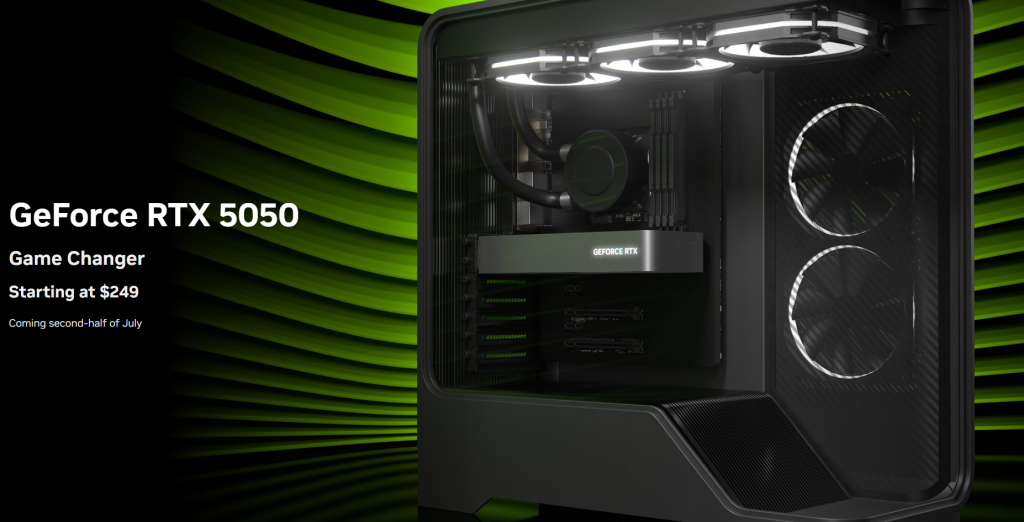In a move that has stirred excitement among PC gamers, NVIDIA is reportedly set to launch its new GeForce RTX 5050 graphics card in China as soon as July 1st, potentially ahead of its global release. This news has surfaced on NVIDIA’s Chinese website, suggesting that gamers in that region may get their hands on the card well before international markets.
GeForce RTX 5050 Launch Potential in China
Details surrounding the GeForce RTX 5050 have been circulating for some time, and earlier reports indicated that NVIDIA was encouraging its board partners to prepare for a launch on July 1st. Although the GPU was revealed shortly after this announcement, the official retail release date appeared to be set for July 2nd. However, the narrative seems to differ for the Chinese market, where the NVIDIA.cn website simply states that the RTX 5050 will be available in July, with no specific date provided.
This discrepancy has led to speculation that the launch might indeed occur earlier in China than in other regions, an idea supported by various gaming news outlets. According to a translation of the Chinese website, NVIDIA may be positioning itself to capitalize on the high demand for new graphics technology in the region. In a press release from NVIDIA, the company mentions that drivers for the RTX 5050 cards will be available in early July, suggesting that some form of launch will take place around that time. As highlighted by NVIDIA, the rollout of software support for the new GPUs will coincide with the hardware launch.
The Performance and Benchmarks of the RTX 5050
While the launch date is being eagerly anticipated, initial benchmarks for the GeForce RTX 5050 have raised concerns among potential buyers. Early testing suggests that the GPU may deliver performance levels similar to the previous generation, but with noticeable limitations. Reports from WCCFTech indicate that while the RTX 5050 aims to offer 60-class performance, it may fall short in various gaming scenarios.
The expectation is that the RTX 5050 will cater primarily to casual gamers or those looking to upgrade from much older cards. It may not compete with more powerful models in NVIDIA’s lineup, such as the RTX 3060 or RTX 3070. This could influence consumer decisions, especially given the ongoing semiconductor shortage and the rising prices of PC components.
Furthermore, NVIDIA’s strategic release of the RTX 5050 in China before other regions could serve multiple purposes. It may allow the city to gauge consumer demand and performance metrics before a wider global rollout. This strategy aligns with NVIDIA’s past approaches to releasing products in waves—testing the waters in specific markets before making broader commitments.
Consumer Sentiment and Market Response
The gaming community’s reaction to these developments has been mixed. Some gamers express anticipation for the new technology, eager to see how it performs against its competition. Others remain cautious, concerned about the RTX 5050’s potential limitations based on preliminary benchmarks.
“As a budget-conscious gamer, I’m hopeful that if the RTX 5050 can deliver good performance, it will provide a worthwhile upgrade path,” commented one user on the NVIDIA forums. “But if it’s not that much better than older models, I might hold off.” This sentiment reflects the broader hesitance among gamers, particularly in an era where high-performance graphics cards are critical for an optimal gaming experience.
Moreover, the global PC market continues to navigate through challenges imposed by the semiconductor shortage and fluctuating prices. According to Statista, the demand for GPUs remains high, with the market growing significantly in recent years. The potential for an earlier launch of the RTX 5050 in China could provide NVIDIA a competitive edge, but it also raises questions about how well the card will meet expectations in terms of performance and value.
As consumers eagerly await further announcements, the anticipation around the RTX 5050 highlights the ongoing evolution of gaming technology and the strategies employed by companies like NVIDIA to stay ahead in a rapidly changing market.

